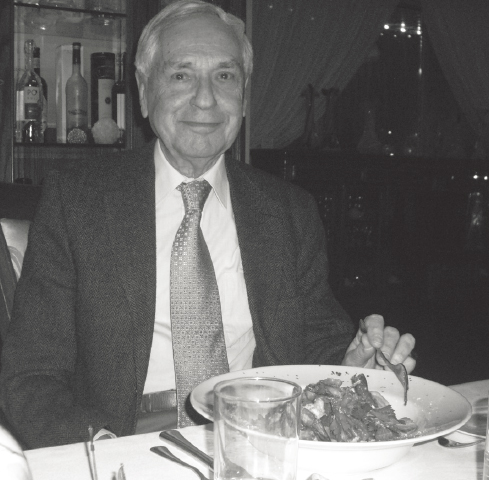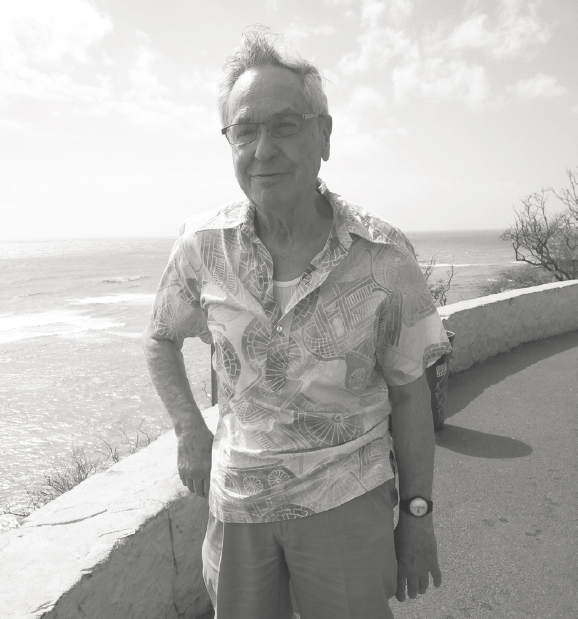

TONY F. W. EMBLETON
1929–2020
Elected in 1987
“For outstanding contributions and international leadership in engineering acoustics.”
BY SHEILA EMBLETON SUBMITTED
BY THE NAE HOME SECRETARY
TONY FREDERICK WALLACE EMBLETON, a leader in noise control engineering and acoustical measurement techniques, as well as in standards development and several professional organizations, died November 13, 2020, at the age of 91 after a 7-year battle with bladder and prostate cancers.
Tony was born October 1, 1929, to Frederick William Howard Embleton and Lucy Violet Muriel (née Wallace) Embleton in Hornchurch, Essex, England, now part of the London borough of Havering. He graduated from Brentwood College School in 1947. Several generations of his family had been involved in international merchant trade, and he was the first in his family to attend university. In 1947 he enrolled at Imperial College, part of the University of London, with a Royal Scholarship, receiving an honors BSc in physics in 1950.
In 1949 he joined the newly formed acoustics group in the Physics Department at Imperial College, under R.W.B. (Ray) Stephens, and earned a PhD in physics for his experimental
___________________
This tribute is based on a number of sources, including extensively on the encomium written by Edgar Shaw on the occasion of Tony’s receipt of the Acoustical Society of America’s Silver Medal in Noise in 1986, a 1994 interview in the American Institute of Physics oral history archive (aip.org/history-programs/niels-bohr-library/oral-histories/5199), and recollections of his colleagues Gilles Daigle and Mike Stinson.
work on finite amplitude waves in 1952. He later received a DSc from the University of London.
A 1-year postdoctoral fellowship at the National Research Council of Canada in Ottawa turned into a permanent position in the Acoustics Section in the Division of Physics. He became a principal research officer in 1974, head of the Acoustics Section in 1985, and retired in 1990 as head of acoustics and mechanical standards. He then moved to Nobleton, Ontario, just northwest of Toronto, to be near family, but remained active for a number of years thereafter in several professional organizations.
In the early 1950s the intense noise generated by large suction rolls in the production of paper was a serious industrial concern in Canada. Tony worked with George Thiessen, then head of the Acoustics Section at the Canadian NRC, to demonstrate a considerable noise reduction by substituting the simple rows of holes in the cylinders (through which the air flowed, generating a quick burst of noise) with more complex patterns, in effect smoothing out the bursts of noise. The success of this project showed the value of fundamental research in support of noise control, and the solution of industrial problems more generally, and was key to launching the reputation of the NRC lab in noise control, both in Canada and internationally. Similar successful projects followed through the 1960s.
Interestingly, the measures that reduced noise in machinery often resulted in improvements in their mechanical efficiency as well. One excellent example of this is Tony’s first patent, filed in 1969 with Thiessen (“stator blading for noise reduction in turbo-machinery”), which increased efficiency in jet engines while quietening them, an advance eagerly adopted around the world. Tony’s other patent, “mufflers for percussive pneumatic machines,” filed in 1980 with Stanley Baldwin and Vernon Hampton, not only quietened pneumatic drills but led to higher drilling speeds, less icing in the muffler, and less vibration (often a source of physical damage to miners’ hands).
Other very practical projects during this time involved measurement of train noise in relation to the use of adjacent land, including the efficacy of planting trees as potential noise
barriers, and office noise and its dependence on the acoustical reflectivity of walls, ceilings, and floors.
In the 1970s Tony’s interest in sound propagation outdoors was rekindled due to growing public and governmental concerns about urban noise, in particular from traffic. This led to a series of theoretical and experimental studies of sound propagation outdoors, some in partnership with Joe Piercy, addressing the effect of the ground on near-horizontal sound propagation, measurement of ground impedance, acoustic characteristics of actual ground surfaces (e.g., asphalt, gravel, grass, snow, sloping terrain), phase and amplitude fluctuations due to turbulence, refraction due to wind and temperature, and the special characteristics of moving noise sources. There were many practical applications to airport and vehicle noise and the utility of highway noise barriers (some of which had more success psychologically than in physical reality).
Tony was author or coauthor of more than 50 scientific papers, many technical reports, invited articles, and book chapters. The latter, particularly “Sound in Large Rooms” and “Mufflers” (both in Leo Beranek’s 1971 Noise and Vibration Control; McGraw-Hill) were the standard reference works in the field for several decades.
He was a visiting lecturer at the University of Ottawa, Carleton University, and the Massachusetts Institute of Technology, and a seminar leader at the NASA-ASEE Summer School (Old Dominion University), the US Environmental Protection Agency Noise Technology Symposium in Dallas, and the Government of Alberta Seminar on Transportation Noise. He gave keynote or invited plenary lectures at several of the most prestigious international conferences in his field.
Tony was equally dedicated to the profession more generally, with numerous editorial and professional administrative commitments in Canada, the United States, and internationally, with contributions not only to acoustics but also to other fields upon which his work touched. He was a key participant in discussions to form a national acoustics organization in Canada, and was elected the first secretary of the Canadian Committee on Acoustics (later the Canadian
Acoustical Association), later serving on its board of directors. He was the founding editor in chief of Acoustics and Noise Control in Canada/L’acoustique et la lutte antibruit au Canada (1972–75; later Canadian Acoustics/Acoustique canadienne). For the Acoustical Society of America (ASA), he was a member of and chaired the Technical Committee on Noise, served on a number of both technical and administrative committees, including the executive council and the technical council, as vice president, acting president, president (1980–81), and later standards director, even after retirement. He was associate editor of the Journal of the Acoustical Society of America. He served in many capacities with the Institute of Noise Control Engineering (INCE) and for the International Institute of Noise Control Engineering, and was on the editorial board of the Noise Control Engineering Journal. He chaired the NRC Associate Committee on Machinery Noise and Acoustics and Noise Control Committee of the Canadian Standards Association, and was a member of the Noise Subcommittee of the Canadian Pulp and Paper Association.
He was also engaged in his community, elected to the Rockcliffe Park Public School Board for the last few years before it amalgamated with the Ottawa School Board (at which point he successfully resisted all entreaties to run for the larger board).
Tony was a skilled meeting organizer. He was the technical program chair for the 1986 International Congress on Acoustics in Toronto, technical chair for the ASA meeting in 1968 (Ottawa) and the first three joint meetings in Honolulu with the Acoustical Society of Japan in 1978, 1988, and 1996, and general chair of the 1981 meeting (Ottawa). The final meeting that he attended was in Honolulu in 2016, again joint with the Acoustical Society of Japan, where he knew he would find many old and new professional friends.
He enjoyed meeting so many people from varied walks of life, often through noise-related consultancy, and had connections in many places, such as the Canadian Passport Office (open-plan offices and noisy passport printing machines were not a good combination); throughout Europe, in association
with NATO scientific committee work involving outdoor sound propagation; and the Ottawa Police, whom he assisted with countless noise complaints over the years.
He was proud of his contributions as the scientist on the first of the NRC’s many Industrial Research Assistance Program projects, which took him to a noisy underground mine in Thompson, Manitoba; his service as a noise consultant on the world’s first next-to-the-runway airport hotel built by a major hotel chain (Hilton Dorval Airport, now Sheraton Montreal Airport, with its strategically angled windows); his suggestion of a novel way to scare birds away at Vancouver Airport; and the evidence he provided for the Royal Canadian Mounted Police as to whether a gun-silencer actually did quieten the gun (only one over the years did not, resulting in an accused who was very surprised but grateful for his acquittal).
He enjoyed encouraging younger scientists and engineers, particularly, of course, in acoustics, and was an advocate and mentor for women in science and engineering. For several decades there was a steady flow of postdoctoral fellows and occasionally sabbatical visitors in his NRC lab in Ottawa, many from India and Japan, and later from Europe and the United States. These led to long-term friendships and invitations to lecture abroad.
His work attracted considerable recognition. In 1964 he received the ASA’s Biennial Award (later renamed the R. Bruce Lindsay Award) and was elected a fellow. He was a corecipient (with Joe Piercy) of the Arch T. Colwell Merit Award of the Society of Automotive Engineers in 1974. In 1976 he delivered the Rochester Institute of Technology’s second annual Distinguished John Wiley Jones Lecture, titled “Noise Control from the Ancient Past to the Near Future.” He received the ASA’s Silver Medal for Noise in 1985, and in 2002 its Gold Medal for “fundamental contributions to understanding outdoor sound propagation and noise control and for leadership in the Society.” He was elected a fellow of the Royal Society of Canada in 1978 and served as its treasurer (1982–85); he remained an active member and was looking forward to the society’s annual meeting in Toronto (unfortunately virtual in
2020) but sadly he passed away 2 weeks before the meeting. He was elected a foreign member of the US National Academy of Engineering in 1987.
Tony married Eileen Blackall in 1953. She had a PhD in chemistry from University College London; they had met in their Russian Reading Knowledge class. She passed away in 2016. They are survived by daughter Dr. Sheila Embleton, son-in-law Dr. Wolfgang Ahrens, and a granddaughter, as well as relatives in England, Australia, and Switzerland.








